

Amun. "Amen Ra" redirects here.
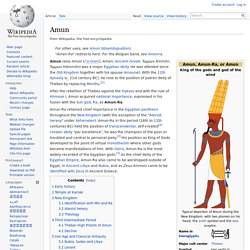
For the Belgian band, see Amenra. Amun (also Amon (/ˈɑːmən/), Amen; Ancient Greek: Ἄμμων Ámmōn, Ἅμμων Hámmōn) was a major Egyptian deity. He was attested since the Old Kingdom together with his spouse Amaunet. With the 11th dynasty (c. 21st century BC), he rose to the position of patron deity of Thebes by replacing Monthu.[1] Anyanwu. Anyanwu (Igbo: Eye of the Sun) is an Igbo deity that is believed to dwell in the sun.
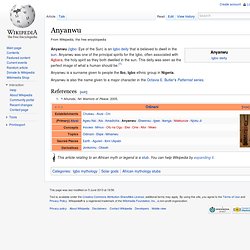
Anyanwu was one of the principal spirits for the Igbo, often associated with Agbara, the holy spirit as they both dwelled in the sun. This deity was seen as the perfect image of what a human should be.[1] Anyanwu is a surname given to people the Ibo, Igbo ethnic group in Nigeria. Anyanwu is also the name given to a major character in the Octavia E. Butler's Patternist series. Jump up ^ Añunobi, Nri Warriors of Peace. 2005. Aten. Atum. Atum (/ɑ-tum/), sometimes rendered as Atem or Tem, is an important deity in Egyptian mythology.
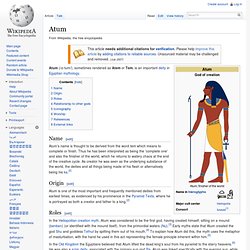
Name[edit] Atum's name is thought to be derived from the word tem which means to complete or finish. Bastet. Photograph of an alabaster cosmetic jar topped with a lioness, representing Bast, an 18th dynasty burial artifact from the tomb of Tutankhamun circa 1323 BC - Cairo Museum Bastet was a goddess in ancient Egyptian religion, worshipped as early as the Second Dynasty (2890 BC).
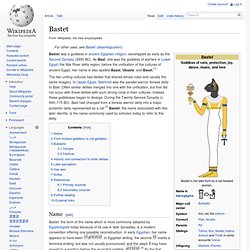
As Bast, she was the goddess of warfare in Lower Egypt, the Nile River delta region, before the unification of the cultures of ancient Egypt. Her name is also spelled Baast, Ubaste, and Baset.[1] The two uniting cultures had deities that shared similar roles and usually the same imagery. Horus. Horus is one of the oldest and most significant deities in ancient Egyptian religion, who was worshipped from at least the late Predynastic period through to Greco-Roman times.

Different forms of Horus are recorded in history and these are treated as distinct gods by Egypt specialists.[1] These various forms may possibly be different perceptions of the same multi-layered deity in which certain attributes or syncretic relationships are emphasized, not necessarily in opposition but complementary to one another, consistent with how the Ancient Egyptians viewed the multiple facets of reality.[2] He was most often depicted as a falcon, most likely a lanner or peregrine, or as a man with a falcon head.[3] Etymology[edit] Horus was also known as Nekheny, meaning "falcon". Some have proposed that Nekheny may have been another falcon-god, worshipped at Nekhen (city of the hawk), with which Horus was identified from early on. Note of changes over time[edit] Khepri. Khepri (also spelled Khepera, Kheper, Khepra, Chepri) is a god in ancient Egyptian religion.
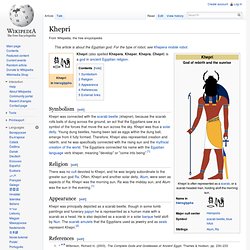
Symbolism[edit] Khnum. Khnum (/kəˈnuːm/; also spelled Khnemu) was one of the earliest Egyptian deities, originally the god of the source of the Nile River.
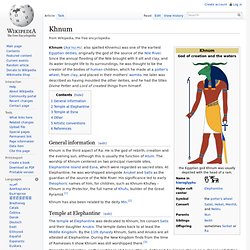
Since the annual flooding of the Nile brought with it silt and clay, and its water brought life to its surroundings, he was thought to be the creator of the bodies of human children, which he made at a potter's wheel, from clay, and placed in their mothers' wombs. He later was described as having moulded the other deities, and he had the titles Divine Potter and Lord of created things from himself. General information[edit] Temple at Elephantine[edit] The temple at Elephantine was dedicated to Khnum, his consort Satis and their daughter Anukis. Magec. Magec (Guanche Berber Ma-ɣeq, "possesses radiance" or "mother of brightness" [1]), in Tenerife,[2] was the god or goddess (actual gender is unknown) of the Sun and the light and also thought to be one of the principal divinities in Guanche religion.

According to legend, Magec was captured by Guayota and held him or her prisoner inside Teide; Magec was later liberated by Achamán. See also[edit] Guanche Religion References[edit] Mawu. After creating the earth and all life and everything else on it, she became concerned that it might be too heavy, so she asked the primeval serpent, Aido Hwedo, to curl up beneath the earth and thrust it up in the sky.

When she asked Awe, a monkey she had also created, to help out and make some more animals out of clay, he boasted to the other animals and challenged Mawu. Gbadu, the first woman Mawu had created, saw all the chaos on earth and told her children to go out among the people and remind them that only Mawu can give Sekpoli - the breath of life.
Gbadu instructed her daughter, Minona, to go out among the people and teach them about the use of palm kernels as omens from Mawu. When Awe, the arrogant monkey climbed up to the heavens to try to show Mawu that he too could give life, he failed miserably. Mawu made him a bowl of porridge with the seed of death in it and reminded him that only she could give life and that she could also take it away. Nefertem. Nefertem Nefertem (/ˈnɛfərˌtɛm/; possibly "beautiful one who closes" or "one who does not close"; also spelled Nefertum or Nefer-temu) was, in Egyptian mythology, originally a lotus flower at the creation of the world, who had arisen from the primal waters.[1] Nefertem represented both the first sunlight and the delightful smell of the Egyptian blue lotus flower, having arisen from the primal waters within an Egyptian blue water-lily, Nymphaea caerulea.
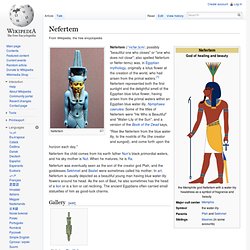
Some of the titles of Nefertem were "He Who is Beautiful" and "Water-Lily of the Sun", and a version of the Book of the Dead says, "Rise like Nefertem from the blue water lily, to the nostrils of Ra (the creator and sungod), and come forth upon the horizon each day. " Nefertum was eventually seen as the son of the creator god Ptah, and the goddesses Sekhmet and Bastet were sometimes called his mother. In art, Nefertum is usually depicted as a beautiful young man having blue water-lily flowers around his head. Gallery[edit] References[edit] Ngai. Ngai (Enkai, En-kai, Engai, Eng-ai, Mweai, Mwiai) is the supreme God in the religions of the Kamba, Kikuyu and Maasai nationalities of Kenya.
According to the Kikuyu beliefs, he lives on the holy mountain Kirinyaga (Mount Kenya). According to the Kamba, he lives somewhere in a hiding place and no one knows where. The Maasai of Kenya in their creation narrative recount the origin of humanity to be fashioned by the Creator Enkai from a single tree or leg which split into three pieces. Ptah. Ra. Ra /rɑː/[1] or Re /reɪ/ (Egyptian: 𓂋ꜥ, rˤ) is the ancient Egyptian solar deity. By the Fifth Dynasty (2494 to 2345 BC) he had become a major god in ancient Egyptian religion, identified primarily with the midday sun. The meaning of the name is uncertain, but it is thought that if not a word for 'sun' it may be a variant of or linked to words meaning 'creative power' and 'creator'.[2] Sekhmet. In Egyptian mythology, Sekhmet /ˈsɛkˌmɛt/[1] or Sachmis (/ˈsækmɨs/; also spelled Sakhmet, Sekhet, or Sakhet, among other spellings) was originally the warrior goddess as well as goddess of healing for Upper Egypt, when the kingdom of Egypt was divided.
She is depicted as a lioness, the fiercest hunter known to the Egyptians. It was said that her breath formed the desert. Sopdu. Sopdu (also rendered Septu or Sopedu) was a god of the sky and of eastern border regions in ancient Egyptian religion.[1] Sopdu Sopdu's name is composed of the hieroglyph for sharp, a pointed triangle, and the 3rd person plural suffix (a quail); thus a literal translation of his name is sharp ones.[2] He was said, in the Pyramid Texts, to protect the teeth of the deceased pharaoh.[1] Sopdu was depicted as a falcon sitting on a religious standard, often with a two-feathered crown on his head and a flail over his shoulder.
In his border-guarding role he was shown as a Near Eastern warrior, with a shemset girdle and an axe or spear.[1] ^ Jump up to: a b c d e Wilkinson, Richard H. (2003).